Marketing communications SECTION 18. 1 What You’ll

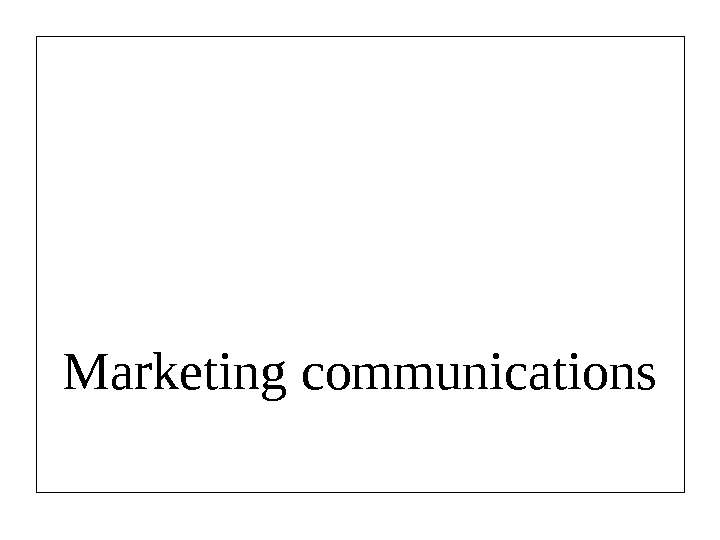

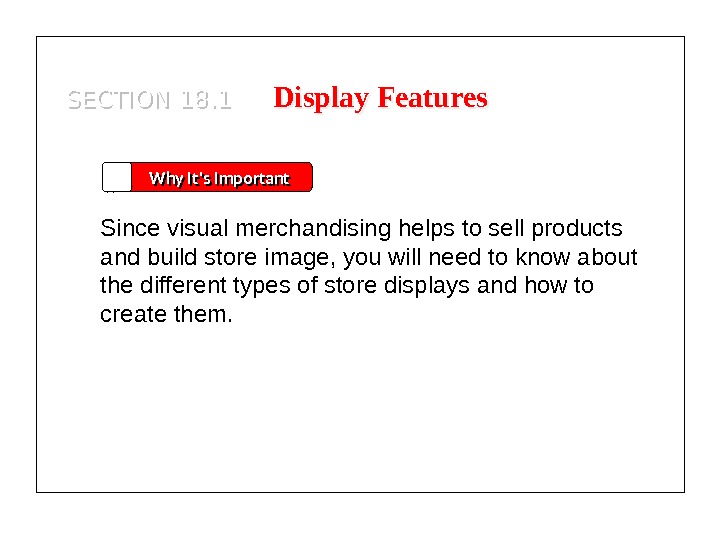










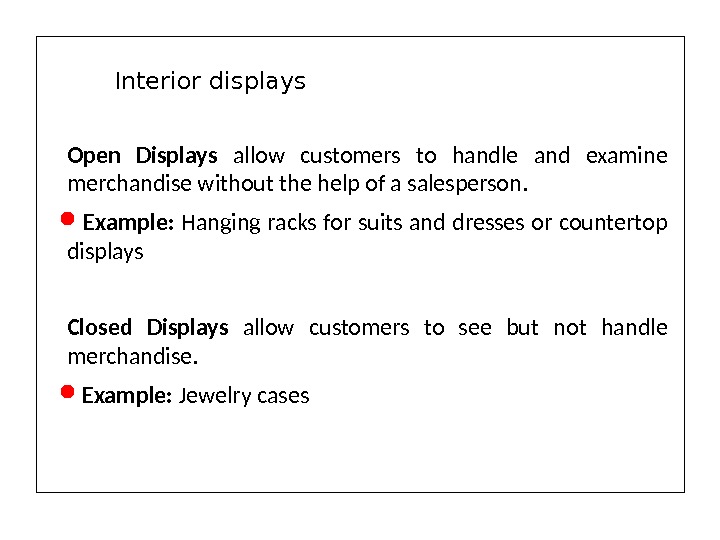






















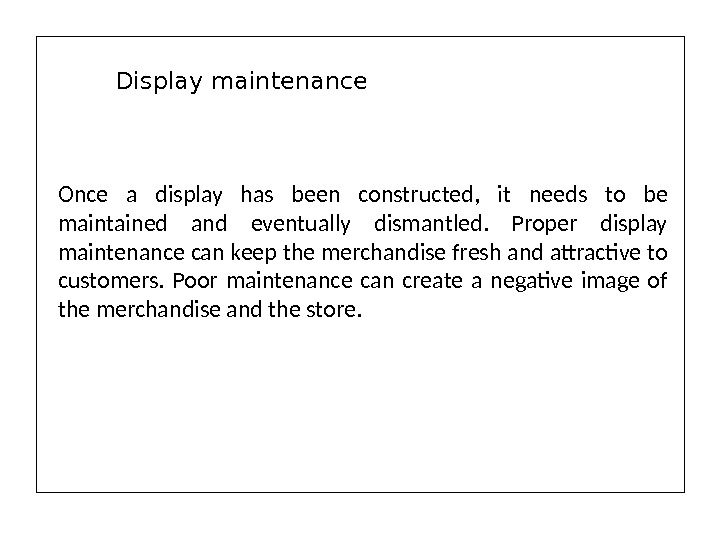
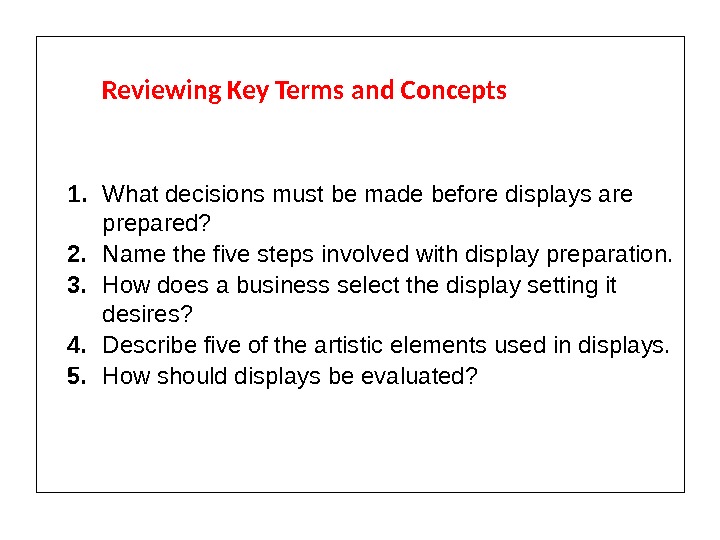

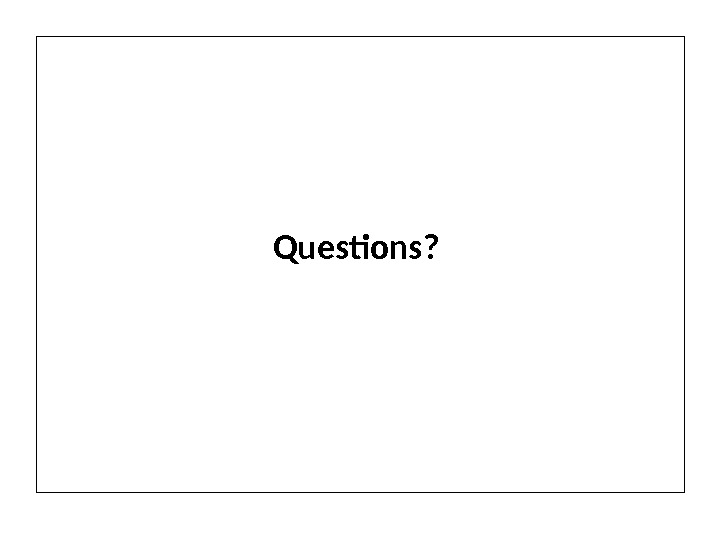
marketing_communications_session_2.ppt
- Размер: 224.7 Кб
- Количество слайдов: 40
Описание презентации Marketing communications SECTION 18. 1 What You’ll по слайдам
 Marketing communications
Marketing communications
 SECTION 18. 1 What You’ll Learn The concepts of visual merchandising and display Important display features that contribute to a store’s image The various types of displays Display Features
SECTION 18. 1 What You’ll Learn The concepts of visual merchandising and display Important display features that contribute to a store’s image The various types of displays Display Features
 SECTION 18. 1 Display Features Why It’s Important Since visual merchandising helps to sell products and build store image, you will need to know about the different types of store displays and how to create them.
SECTION 18. 1 Display Features Why It’s Important Since visual merchandising helps to sell products and build store image, you will need to know about the different types of store displays and how to create them.
 SECTION 18. 1 Display Features Key Terms visual merchandising display storefront marquee store layout fixtures
SECTION 18. 1 Display Features Key Terms visual merchandising display storefront marquee store layout fixtures
 Promotion is any form of communication a business or organization uses to inform, persuade, or remind people about its products. Promotional mix is a combination of the different types of promotion. A business decides on the promotional mix that will be most effective in persuading potential customers to purchase its products. The Concept of the Promotional Mix
Promotion is any form of communication a business or organization uses to inform, persuade, or remind people about its products. Promotional mix is a combination of the different types of promotion. A business decides on the promotional mix that will be most effective in persuading potential customers to purchase its products. The Concept of the Promotional Mix
 Types of Promotion There are four basic types of promotion: personal selling advertising sales promotion public relations
Types of Promotion There are four basic types of promotion: personal selling advertising sales promotion public relations
 Visual merchandising refers to the coordination of all physical elements in a place of business so that it projects the right image to its customers. = a type of consumer sales promotion The «right» image invites interest in the merchandise or services, encourages purchasing, and makes customers feel good about where they are doing business. Displays refer to the visual and artistic aspects of presenting a product to a target group of customers. Visual Merchandising and Displays
Visual merchandising refers to the coordination of all physical elements in a place of business so that it projects the right image to its customers. = a type of consumer sales promotion The «right» image invites interest in the merchandise or services, encourages purchasing, and makes customers feel good about where they are doing business. Displays refer to the visual and artistic aspects of presenting a product to a target group of customers. Visual Merchandising and Displays
 Visual merchandising is used to create a positive shopping experience that makes customers want to return. To achieve this, stores consider four key elements: storefront store layout store interior displays Elements of Visual Merchandising
Visual merchandising is used to create a positive shopping experience that makes customers want to return. To achieve this, stores consider four key elements: storefront store layout store interior displays Elements of Visual Merchandising
 The total exterior of a business is known as the storefront. It includes the store’s sign, marquee, outdoor lighting, banners, windows, and the building itself (its design and setting). Signs The store sign offers the first impression and therefore should make a statement about the business. It should be easily recognizable and help create the store’s image. Marquee A marquee is an architectural canopy that extends over a store’s entrance. Marquees can be found over most theater entrances. Storefront
The total exterior of a business is known as the storefront. It includes the store’s sign, marquee, outdoor lighting, banners, windows, and the building itself (its design and setting). Signs The store sign offers the first impression and therefore should make a statement about the business. It should be easily recognizable and help create the store’s image. Marquee A marquee is an architectural canopy that extends over a store’s entrance. Marquees can be found over most theater entrances. Storefront
 Entrances are usually designed with customer convenience and store security in mind. They can also contribute to a store’s image. Window Displays A display window begins the selling process before a customer enters the store. There are two types of window displays: promotional (promotes products) and institutional (promotes the store as a whole). Storefront
Entrances are usually designed with customer convenience and store security in mind. They can also contribute to a store’s image. Window Displays A display window begins the selling process before a customer enters the store. There are two types of window displays: promotional (promotes products) and institutional (promotes the store as a whole). Storefront
 Store layout is the way floor space is used to facilitate sales and serve the customer. There are four kinds of space: Store layout Selling space for interior displays, sales demonstrations, and sales transactions Merchandising space for inventory Personnel space for employee lockers, lunch breaks, and restrooms Customer space for restrooms, a cafe, or dressing rooms
Store layout is the way floor space is used to facilitate sales and serve the customer. There are four kinds of space: Store layout Selling space for interior displays, sales demonstrations, and sales transactions Merchandising space for inventory Personnel space for employee lockers, lunch breaks, and restrooms Customer space for restrooms, a cafe, or dressing rooms
 = The selection of floor and wall coverings, lighting, colors, and store fixtures can powerfully affect the store image. Example: Thick carpeting can portray a luxurious image. Fixtures are permanent or movable store furnishings, such as display cases, counters, shelving, racks, and benches. Store interior
= The selection of floor and wall coverings, lighting, colors, and store fixtures can powerfully affect the store image. Example: Thick carpeting can portray a luxurious image. Fixtures are permanent or movable store furnishings, such as display cases, counters, shelving, racks, and benches. Store interior
 Retailers use interior displays to show merchandise, provide customers with product information, get customers to stop and shop at the store, reinforce advertising, and promote the store’s image. There are five main types: Interior displays open displays closed displays architectural displays point-of-purchase displays store decorations
Retailers use interior displays to show merchandise, provide customers with product information, get customers to stop and shop at the store, reinforce advertising, and promote the store’s image. There are five main types: Interior displays open displays closed displays architectural displays point-of-purchase displays store decorations
 Open Displays allow customers to handle and examine merchandise without the help of a salesperson. Example: Hanging racks for suits and dresses or countertop displays Closed Displays allow customers to see but not handle merchandise. Example: Jewelry cases. Interior displays
Open Displays allow customers to handle and examine merchandise without the help of a salesperson. Example: Hanging racks for suits and dresses or countertop displays Closed Displays allow customers to see but not handle merchandise. Example: Jewelry cases. Interior displays
 Architectural displays consist of model rooms that show customers how merchandise such as rugs and furniture might look in their homes. Point-of-purchase displays are designed to promote impulse purchases. They are effective at supporting new products. Point-of-purchase displays are usually supplied by a product manufacturer for use at or near the cash register. Store decorations are displays such as banners, signs, and props used to evoke the mood of seasons or holidays. Interior displays
Architectural displays consist of model rooms that show customers how merchandise such as rugs and furniture might look in their homes. Point-of-purchase displays are designed to promote impulse purchases. They are effective at supporting new products. Point-of-purchase displays are usually supplied by a product manufacturer for use at or near the cash register. Store decorations are displays such as banners, signs, and props used to evoke the mood of seasons or holidays. Interior displays
 Reviewing Key Terms and Concepts 1. What is visual merchandising? 2. Why is display considered part of visual merchandising? 3. How do exterior and interior features help a store’s image? 4. List two different types of window displays. 5. Describe the five different types of interior displays used by retailers.
Reviewing Key Terms and Concepts 1. What is visual merchandising? 2. Why is display considered part of visual merchandising? 3. How do exterior and interior features help a store’s image? 4. List two different types of window displays. 5. Describe the five different types of interior displays used by retailers.
 Is it necessary for staff members who work with visual merchandising to know basic sales promotion techniques? Justify your response. Thinking Critically
Is it necessary for staff members who work with visual merchandising to know basic sales promotion techniques? Justify your response. Thinking Critically
 SECTION 18. 2 What You’ll Learn The steps used in designing and preparing displays The artistic considerations involved in display preparation The maintenance considerations for displays Artistic Design
SECTION 18. 2 What You’ll Learn The steps used in designing and preparing displays The artistic considerations involved in display preparation The maintenance considerations for displays Artistic Design
 Artistic Design Why It’s Important Visual merchandisers must know the rules for artistic design for displays that attract customers and keep them coming back. SECTION 17.
Artistic Design Why It’s Important Visual merchandisers must know the rules for artistic design for displays that attract customers and keep them coming back. SECTION 17.
 Key Terms complementary colors adjacent colors proportion formal balance informal balance. SECTION 17. 2 Artistic Design
Key Terms complementary colors adjacent colors proportion formal balance informal balance. SECTION 17. 2 Artistic Design
 In the retail environment, a display has about three to eight seconds to attract a customer’s attention, create a desire, and sell a product. A business must target its displays carefully to appeal to its customers. Display design and selection involves five steps: 1. Selecting merchandise for display. 2. Selecting the display. 3. Choosing a setting. 4. Manipulating artistic elements. 5. Evaluating completed displays. Display and Design Preparation
In the retail environment, a display has about three to eight seconds to attract a customer’s attention, create a desire, and sell a product. A business must target its displays carefully to appeal to its customers. Display design and selection involves five steps: 1. Selecting merchandise for display. 2. Selecting the display. 3. Choosing a setting. 4. Manipulating artistic elements. 5. Evaluating completed displays. Display and Design Preparation
 Merchandise selected for display must have sales appeal, be visually appealing, and be appropriate for the season and the store’s location. New, popular, and best-selling products are often selected. Step 1: Selecting Merchandise for Display
Merchandise selected for display must have sales appeal, be visually appealing, and be appropriate for the season and the store’s location. New, popular, and best-selling products are often selected. Step 1: Selecting Merchandise for Display
 The merchandise selected largely determines the type of display that is used. There are four kinds of displays: A one-item display shows a single item. A line-of-goods display shows one kind of product but features several brands, sizes, or models. A related-merchandise display features items that are meant to be used together. An assortment display features a collection of unrelated items. Step 2: Selecting the Display
The merchandise selected largely determines the type of display that is used. There are four kinds of displays: A one-item display shows a single item. A line-of-goods display shows one kind of product but features several brands, sizes, or models. A related-merchandise display features items that are meant to be used together. An assortment display features a collection of unrelated items. Step 2: Selecting the Display
 Displays can be presented in a number of different types of settings. A realistic setting depicts a room or recognizable locale. A semi-realistic setting suggests a room or locale but leaves the details to the viewer’s imagination. An abstract setting does not imitate (or even try to imitate) reality. It focuses on form and color rather than on reproducing actual objects. Step 3: Choosing a Setting
Displays can be presented in a number of different types of settings. A realistic setting depicts a room or recognizable locale. A semi-realistic setting suggests a room or locale but leaves the details to the viewer’s imagination. An abstract setting does not imitate (or even try to imitate) reality. It focuses on form and color rather than on reproducing actual objects. Step 3: Choosing a Setting
 The artistic elements of a display influence your perception of a display in ways that you are probably not aware of. Step 4: Manipulating Artistic Elements line color shape direction texture proportion motion lighting
The artistic elements of a display influence your perception of a display in ways that you are probably not aware of. Step 4: Manipulating Artistic Elements line color shape direction texture proportion motion lighting
 Various types of lines create different impressions. Example: Straight lines suggest stiffness and control; curved lines suggest freedom and movement; diagonal lines give the impression of action. Line
Various types of lines create different impressions. Example: Straight lines suggest stiffness and control; curved lines suggest freedom and movement; diagonal lines give the impression of action. Line
 Color can make or break a display. Display colors should contrast with those used on the walls, floors, and fixtures around them. Complementary colors (opposite each other on the color wheel) provide the greatest contrast. Adjacent colors (next to each other on the color wheel) blend well with each other. Color
Color can make or break a display. Display colors should contrast with those used on the walls, floors, and fixtures around them. Complementary colors (opposite each other on the color wheel) provide the greatest contrast. Adjacent colors (next to each other on the color wheel) blend well with each other. Color
 The Color Wheel The color wheel is structured to show both similarities and differences in colors. Which colors are most like each other? Which show the greatest contrast?
The Color Wheel The color wheel is structured to show both similarities and differences in colors. Which colors are most like each other? Which show the greatest contrast?
 Shape refers to the physical appearance, or outline, of a display. Shape is determined by the props, fixtures, and merchandise used in the display. Displays that have little or no distinct shape are called mass displays. They are used to display large quantities and to convey a message of low price. Shape
Shape refers to the physical appearance, or outline, of a display. Shape is determined by the props, fixtures, and merchandise used in the display. Displays that have little or no distinct shape are called mass displays. They are used to display large quantities and to convey a message of low price. Shape
 A good display has direction; it smoothly guides the viewer’s eye over all the merchandise. Displays should have a focal point, which can be created by building the display around an imaginary triangle to keep the eyes moving up and center. Direction
A good display has direction; it smoothly guides the viewer’s eye over all the merchandise. Displays should have a focal point, which can be created by building the display around an imaginary triangle to keep the eyes moving up and center. Direction
 Texture refers to the way the surfaces in a display look together. The contrast between textures creates visual interest. Texture
Texture refers to the way the surfaces in a display look together. The contrast between textures creates visual interest. Texture
 Proportion is the relationship between and among objects in a display. The merchandise should always be the primary focus of a display. Proportion
Proportion is the relationship between and among objects in a display. The merchandise should always be the primary focus of a display. Proportion
 Placing large items with large items and small items with small items in a display is called formal balance. Balancing a large item with several small ones is called informal balance. Balance
Placing large items with large items and small items with small items in a display is called formal balance. Balancing a large item with several small ones is called informal balance. Balance
 Motion can be added to a display through the use of motorized fixtures and props. Motion should be used sparingly or it can become distracting. Motion
Motion can be added to a display through the use of motorized fixtures and props. Motion should be used sparingly or it can become distracting. Motion
 Proper lighting makes merchandise appear more attractive in displays. It is recommended that display lighting be two to five times stronger than a store’s general lighting. Lighting
Proper lighting makes merchandise appear more attractive in displays. It is recommended that display lighting be two to five times stronger than a store’s general lighting. Lighting
 Visual merchandisers should evaluate completed displays by checking to see if they enhance the store’s image, appeal to customers, and promote the product in the best possible way. Step 5: Evaluating Completed Displays
Visual merchandisers should evaluate completed displays by checking to see if they enhance the store’s image, appeal to customers, and promote the product in the best possible way. Step 5: Evaluating Completed Displays
 Once a display has been constructed, it needs to be maintained and eventually dismantled. Proper display maintenance can keep the merchandise fresh and attractive to customers. Poor maintenance can create a negative image of the merchandise and the store. Display maintenance
Once a display has been constructed, it needs to be maintained and eventually dismantled. Proper display maintenance can keep the merchandise fresh and attractive to customers. Poor maintenance can create a negative image of the merchandise and the store. Display maintenance
 Reviewing Key Terms and Concepts 1. What decisions must be made before displays are prepared? 2. Name the five steps involved with display preparation. 3. How does a business select the display setting it desires? 4. Describe five of the artistic elements used in displays. 5. How should displays be evaluated?
Reviewing Key Terms and Concepts 1. What decisions must be made before displays are prepared? 2. Name the five steps involved with display preparation. 3. How does a business select the display setting it desires? 4. Describe five of the artistic elements used in displays. 5. How should displays be evaluated?
 Manufacturers often provide point-of-purchase displays to retailers. If you were a retailer, what criteria would you use in deciding whether or not to accept such a display? Thinking Critically
Manufacturers often provide point-of-purchase displays to retailers. If you were a retailer, what criteria would you use in deciding whether or not to accept such a display? Thinking Critically
 Questions?
Questions?

